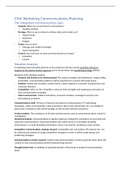CH4: Marketing Communications Planning
The integrated communications plan
- Analysis: Where are we and why to communicate?
o Situation Analysis
- Strategy: What to say to whom to achieve what and at what cost?
o Target Groups
o Objectives
o Budgets
- Tactics: How to do it?
o Message and creative strategies
o Tools Touchpoints
- Control: How well have we done and what should we change?
o Evaluation
o Control
Situation Analysis
A marketing communications plan has to be consistent with the overall marketing objectives,
targeted at the desired market segments and it should reflect the positioning strategy defined.
Elements of the situation analysis:
- Products and brands to be communicated: The unique strengths and weaknesses, unique selling
proposition, communication platform and the arguments to convince the target group.
- Markets: Market size evolution, market shares, market segments, consumer characteristics and
consumer behavior.
- Competitors: Who are the competitors, what are their strengths and weaknesses and what are
their communication strategies.
- Macro-environment: Political restrictions, economic situation, sociological concerns and
technological evolutions
Communications audit: All forms of internal and external communications (TV advertising,
newspaper, online communication, sales promotions, direct mail, sponsorship, etc.) are studied to
assess their consistency with overall strategy, as well as their internal consistency.
Vertical analysis: The consistency of all tools and instruments used to communicate about a brand is
investigated.
Horizontal analysis: Communications in specific media are checked for consistency across brand and
corporate communications. Horizontal analysis only makes sense in a monolithic branding
environment. In a multi-branding environment, there is no need for consistency across brands.
Competitor communications strategy research: Competitive ads, promotions, PR material, etc. can
be collected and analyzed to judge competitive strategies in order to define target groups and
positioning strategies.
Communications content research: Used to help communications creatives generate ideas about the
content of new communications stimuli (brainstorming session).
Thought-starter lists: A multitude of potential benefits of the brand or product to be promoted is
listed.
, Segmenting, targeting and positioning
STP/process; segmenting-targeting-positioning process:
1. Definition of segmentation criteria/Market segmentation: Members of homogeneous
subgroups react in the same way to marketing stimuli and differ in their reactions to these stimuli
from the members of other segments.
2. Definition of segment profiles: Combine segmentation variables to form segmentation profiles.
3. Assessment of the attractiveness of segments: Segment attractiveness will depend on the size
and predicted evolution of sales, buying power and the amount of competition.
4. Selection of target groups/Targeting: Select a number of target groups to focus on, based on
their attractiveness and for which the company has relevant strengths.
5. Definition of the desired unique position in the mind of the targeted consumers/Positioning:
The way a product is perceived by the target group on important attributes and the place in mind
a product occupies relative to its competitors.
Segmentation
Market segmentation: The process of diving consumers into homogeneous groups, that share needs
or react in a comparable way to marketing and communications efforts.
Variables to segment consumer markets:
- Objective variables: Variables that can be measured objectively and straightforwardly.
- Inferred/Psychographic variables: Variables that have to be defined before people can be
classified.
- General variables: Variables that hold in all behavioral circumstances.
- Buyer-specific/Behavior-related variables: Consumers can belong to different segments
depending on the product class or buying situation concerned.
Objective Inferred/Psychographic
General Geographic, income, gender, Social class, personality,
education, life cycle lifestyle
Specific/Behavioral Occasion, loyalty status, user Benefit, buyer readiness
status, usage rate
Geographic segmentation: Divides the market on the basis of continents, climate, nations, regions or
neighborhoods. Consumer behavior and buying patterns often denote cultural differences and
therefore require other marketing mix approaches.
Demographic segmentation: Divides the market on the basis of sex, age, family size, religion, race,
education or income. These variables correlate with other variables such as consumer needs and are
less difficult to measure than other.
Characteristics of generations:
- Baby boomers: Luxury, high-quality products, less critical of marketing techniques and
advertising.
- Generation X: High spending, materialistic, ambitious, need for individualism, critical of
marketing techniques and advertising
- Generation Y/Millennials: High buying power, high expectations of services, marketing and
technologically savvy (well-known), less brand loyal, viral marketing key (because of peer-to-peer
recommendations).




